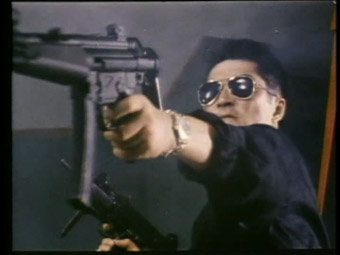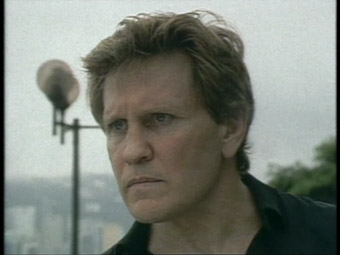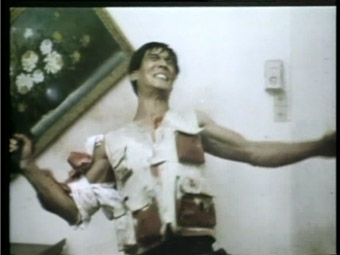|
If
you're one of those people who find formal weddings tiresome –
and I certainly am – you might take a perverse pleasure from
the opening few minutes of Mr. X, as every member of a white-dressed wedding party is slaughtered by armed
goons in what is clearly a carefully planned assault. Who
anybody is at this stage is unclear – half the wedding party
are Chinese, half are Japanese, and the assault team look like
American CIA operatives, albeit with an oriental female leader.
Minutes later we're in New York, and some American guy – the Mr. X of the title – is secretly observing two local Chinese gangs do a dockside drug deal that quickly descends into violent mayhem. Could there be a connection with the wedding massacre? Well, yes and no. Several vicious deaths later, one gang stands triumphant, but not for long, as Mr. X then suddenly mutates into a one-man army and kills everything left moving. Bloody hell, could these guys just pause for a minute and talk?
A few minutes on and we're back in Hong Kong via a news report about a new venture between Chinese and Japanese businessmen. Aha, the dots are starting to connect. Suddenly, the news report is interrupted by an explosion and – oh dear God no – another heavily armed superman appears, this time of Oriental extraction. As he sets about killing wave after wave of the CIA look-alikes, I began wondering how anything ever gets built in Hong Kong if this is how they conduct business.

At
this point, most will realise that all this is less about
plot than the spectacle of slaughter, something the film
absolutely revels in. The slow motion gunplay administered by an icy-cool
assassin in dark sunglasses with a machine gun in each hand
comes across as Z-grade John Woo, but there is none of Woo's
carefully choreographed violence here, just the same ten
sunglassed goons piling stupidly and repeatedly through a door and being
shot to the ground by After Effects-style bullet-hits (bullets,
generally, do not cause sparks when they hit the sleeves
of tailored suits) over and over again. Man, how many times
can you watch that same long haired guy and that one with the
distinctive angular face get shot and die before your brain
screams "ENOUGH!"? In my case, just once.
We're twenty minutes in before a particularly loathsome American who I will call Mr. Exposition explains to Mr. X (and us) just what has been going on. Mr. Exposition wants Mr. X to go to Hong Kong and help the small group of Chinese (or, as he calls them, "Chinks") who want nothing to do with the pact between the Triads and the Yakuza ("Japs") that started all this. He wants him to kill one guy in particular first, not because of any threat the man represents, but because he turns Exposition's stomach and reminds him of "a slanty-eyed toad." And so we're 25 minutes in and Mr. X is in Hong Kong telling the kindly old Chaplin Chang (the film's producer, and that's his real name) and his associates the way things are gonna be now that this horse is in town, and all I want is for Mr. X to become the ex-Mr. X, preferably through the insertion of a live grenade in his anus. No such luck.
To
say that what follows is predictable would be slightly misleading
– certainly it's largely formulaic stuff, but it's also
hard to foresee what a complete arse Mr. X will turn out to
be. Concealing himself in order to slaughter another collection of locals and their business partners, for example, his
thunder is stolen when one of the men whose side he is supposed
to be on turns up and does his job for him. What
does X do? He kills the good guy and growls "I told
you I work alone." What a complete bastard. Somehow
we are supposed to find this idiot engaging, but as played
by Joe Lewis he has all the screen charm of a cactus with
herpes and grace of movement of a hobbled hippopotamus.

Adding
to the confusion is the sneaking suspicion that the film's
mysterious director, a Mr. Ed Woo (hey, we're just one letter shy
of an altogether more notorious filmmaking name there), is actually
a composite of three different filmmakers, all of whom handled
different characters and scenes. The dockside fight at the
start, for example, is energetically staged and choreographed,
whereas just about anything involving gunfire is shabby
at best and often ludicrous (see the above comments). Close quarters
hand-to-hand combat, on the other hand, is superbly staged,
at least when it's left to the Oriental cast members – stripped
of his weapons, Mr. X fights like a big girl's blouse.
This
stylistic schizophrenia is emphasised in the very long three-way
climactic battle, which flips between two Chinese brothers
dressed in white overcoats shooting everything that makes
a noise, two gangland warlords slugging it out with samurai
swords, and Mr. X caught in fisticuffs with a mountain of
muscle posing as a guard. The sword fight is furiously staged,
but the two brothers land us back in low grade John Woo territory,
and as for X – I defy anyone watching his forceless punching
to explain to me how he (inevitably and depressingly) defeats
the Gorgon in human form that he's pitted against. It's
not just that these three parallel stories are staged differently,
they even LOOK different to each other, as if they also
had three separate and uncommunicative cinematographers
as well.
There
are good things in Mr. X, in the aforementioned
close combat fights and swordplay, in the fact that the English,
Chinese and Japanese characters speak in their own languages
rather than in badly dubbed English, and there's even a
very niftily done on-foot chase through the Hong Kong back
streets. But this counts for little when so much else is
so bloody poor, from the ludicrous, one-against-a-hundred
gun battles – where the bad guys clearly have blanks in their guns and high powered magnets in their clothing to attract
the bullets from the hero's weapon – to Mr. X himself, an utterly detestable git who is only likely to find favour
with an undiscriminating audience whose moral values are
four steps to the right of Genghis Khan.
If
you've read any of my previous reviews of 55th Chamber releases,
you'll already have an idea what to expect in terms of picture
and sound quality. Yep, once again we have an NTSC to PAL
conversion, cropped to 4:3 and hauled off of what looks
like a low band tape source. As a result, the picture is
seriously lacking in the areas of sharpness, contrast and
colour integrity. What is surprising (and unusual) is
how clean of dust spots the print is, or at least at first
– a few minutes in they return en masse, and once in residence
there's no shifting the buggers. Interesting end credits
include 'VT Operator' and 'VT Mastering'. Was it actually
shot on film at all?

The mono sound is also low grade stuff, unforgivable for a film made only 11 years ago, but at least unsurprising given the source print and the film's curious rarity. Initially, there are some very obvious synchronisation issues, with words and sound effects missing their mark by almost a second. Although post-dubbing has been common practice in Hong Kong action cinema for years and produces inevitable mismatches of picture and sound, this is clearly a problem with the source print that has not been rectified at the digital stage, most evident when the word "Time!" is seen barked in big close-up, but not heard until the following shot.
The subtitles for the Chinese and Japanese dialogue are burned in, but appear to have been added at the digital stage, resulting in better clarity here than you might expect, at least until 45 minutes in, when the quality noticeably drops, suggesting two different source prints nailed together midway. They do improve again later on.
The usual 55th Chamber collection consists of a UK Promotional Trailer (1:12), which is nothing of the sort and just a montage of action shots from this DVD print cut to some really horrible music, plus a Stills Gallery (1:20), and a plug for some of their other releases.
Mr. X is the generic Hong Kong actioner at its least inspiring, a series of noisy, busy, but largely unexciting action scenes of wildly varying quality and style, strung together by a plot whose cross-cultural potential is buried by shallow character development, over-familiarity, and an offensively awful central character. Fans of fast and furious close-combat kung-fu will find of couple of sequences of real interest, and it's these that momentarily lift the film out of the doldrums and suggest a finer work that could have been. Whether you feel this is worth a fiver is a decision only you can make.
|